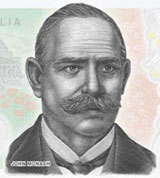Currency index
Advertisements
Australian new one-hundred dollar note

Quick links to banknotes
Third series(2016–present)




Second series(1992–present)





Description
- Size: 158 x 65mm
- Paper type: Polymer
- Colour: Green


The Australian one-hundred dollar note is a denomination of Australian currency. The new polymer banknote was issued on 29 October 2020 and depicts the same historical characters that it has since 1996. A portrait of Аustralian operatic soprano Dame Nellie Melba is featured on the obverse of the note. She became one of the most famous singers of the late Victorian era and the early 20th century and was the first Australian to achieve international recognition as a classical musician. Аn Australian civil engineer and an Australian military commander of the First World War General Sir John Monash is featured on the reverse of the banknote.
Design Features:
Each denomination of the new series of Australian dollar banknotes will feature a different species of Australian wattle and a native bird within a number of the security features. On the $100 banknote, these are the Golden Wattle (Acacia pycnantha) and the Masked Owl.
Portrait of Dame Nellie Melba

This portrait of Dame Nellie Melba, an internationally renowned soprano, is drawn from a photograph in Melba: A Biography published in 1909, written by Agnes G. Murphy.
Melba as Rosina Fhoto

The image is a photograph of Dame Nellie Melba in costume as Rosina in Rossini's Barber of Seville. It was taken by Leopold Emile Reutlinger in 1896. The music score is a small section of Puccini's La Bohème.
Source: Lilydale & District Historical Society.
Monogram

The monogram is from the cover of Melba's homecoming concert tour programme in 1902.
Source: Australian Performing Arts Collection, Arts Centre Melbourne.
Portrait of Sir John Monash

This portrait of Sir John Monash is drawn from a photograph taken in 1912 currently held by the National Library of Australia.
Source: Papers of Sir John Monash, National Library of Australia, MS1884, Series 15, Box 237.
Shrine of Remembrance

The Shrine of Remembrance represents Monash's distinguished military service and his support of veterans following the end of the First World War. Red poppies are often used to signify remembrance.
Fyansford Bridge

The Fyansford Bridge represents Sir John Monash's legacy as an engineer. It was built by Monash & Anderson, a partnership between Monash and Mr J.T. Noble Anderson. The bridge was opened to the public in 1900.
Source: Pictures Collection, State Library Victoria.
Security Features:
Security features can help you to tell if a new Australian one-hundred dollar note is fake or real.
Top-to-bottom window

Look for multiple security features in the clear top-to-bottom window. The window should be an integral part of
the banknote and not an addition. Check that the security features in the window cannot be easily rubbed off.
3D Fan



Tilt the banknote to see a three-dimensional fan with colourful lines.
Colourful Owl



Tilt the banknote to see colours change within the owl's wings.
Reversing 100



Tilt the banknote to see the number ‘100’ change direction within the Shrine of Remembrance.
Fan clear window

Look for a fan in a small clear window.
Rolling colour effect



On the reverse of the Australian one-hundred dollar note in the top-right corner you will see a rolling colour effect, which is visible on both sides of the banknote.



On the obverse of banknote you will see a rolling colour effect, which is visible on both sides of the banknote.
Intaglio print

Feel the distinctive texture of the raised, dark printing.
Tactile Feature

Feel for five raised bumps on each of the long edges of the banknote.
Microprint



Look for tiny, clearly defined text in multiple locations on the banknote. This includes an excerpt from Melba's autobiography Melodies and Memories.
Under UV light



On the obverse of banknote you will see an owl and wattle branch that fluoresce under UV light. On the reverse of the
Australian one-hundred dollar note you will see a serial number and year of print that fluoresce under UV light.
Sources:
rba.gov.au
wikipedia.org




Follow currencyguide.eu